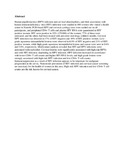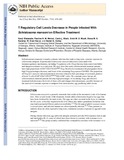| dc.description.abstract | Schistosomiasis mansoni is usually a chronic infection that leads to long-term, systemic exposure to schistosome antigens. Experimental Schistosoma mansoni infection is associated with immunoregulatory mechanisms, including T regulatory cells (Treg) that may help control morbidity and dampen resistance to re-infection. We now show that some schistosomiasis mansoni patients have high proportions of CD3(+)/CD4(+)/CD25(high) Treg. On effective treatment with praziquantel, these high Treg percentages decrease, and fewer of the remaining Treg express CD45RO. The proportion of Treg in S. mansoni-infected patients is inversely related to their percentage of activated, putative effector T cells (CD3(+)/CD4(+)/CD25(medium)/HLA-DR(+) cells). We conclude some, but not all, schistosomiasis mansoni patients develop high percentages of circulating Treg, and effective treatment both decreases the levels of these cells and changes their phenotypes, possibly because of the removal of constant exposure to antigens from intravascular, egg-producing adult worms. | en |


